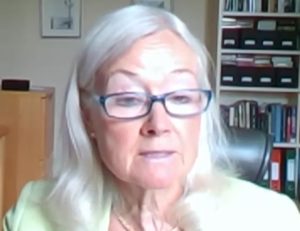 A blue-ribbon commission convened by the National Academy of Sciences (NAS) and the UK’s Royal Society has released a much-anticipated 200-page report on Heritable Human Genome Editing (HHGE).*
A blue-ribbon commission convened by the National Academy of Sciences (NAS) and the UK’s Royal Society has released a much-anticipated 200-page report on Heritable Human Genome Editing (HHGE).*
The report charts a course for limited use of HHGE to help couples have a healthy, biologically related child, once several important criteria have been met.
The commission was co-chaired by two distinguished human geneticists, Dame Kay Davies (University of Oxford) and Rockefeller University president Rick Lifton. The 18-member committee included Broad Institute director Eric Lander, genome editing pioneer Dana Carroll (University of Utah), and Canadian legal scholar Bartha Knoppers (McGill University). The group worked for more than a year to produce the report.
The genesis for the report was the incendiary news in November 2018 that He Jiankui, a young Chinese professor, had undertaken heritable editing resulting in the birth of two CRISPR babies. His team performed genome editing on human embryos using CRISPR-Cas9 technology, targeting the CCR5 gene, aiming to replicate a naturally occurring 32-base deletion that confers HIV resistance. The editing quality was mediocre, unnecessary, and performed in great secrecy, against an overwhelming scientific and medical consensus.
Baby steps
Speaking during a webinar to introduce the HHGE report, Davies summarized the main conclusions of the report: First, “no clinical use should be considered until we can make precise genomic changes without undesired changes.” Second, “before any country decides to approve HHGE, there should be international mechanisms to ensure preclinical mechanisms have been met.” And third, “any clinical use should proceed cautiously” with uses restricted to a particular set of circumstances.

Davies added that the report does not say whether a particular application should be approved, but rather lays out considerations to take into account when assessing the proposed uses of the technology.
One of two commission members from China, Haoyi Wang (Chinese Academy of Sciences), cautioned that the criteria for safe HHGE have not yet been met. “Neither the [editing] technologies nor sequencing embryonic DNA to check for off-target effects are reliable enough,” he said. “Researchers must prove high efficiency in [animal and preclinical] models to move into human embryos.”
Michele Ramsay (University of Witwatersrand, South Africa), said the commission identified three criteria to evaluate what might be amenable to HHGE: the nature or severity of the disease, knowledge about genotype-phenotype correlations, and the availability of alternative options (such as prenatal genetic testing, PGT) for couples to have biological children.
Ramsay highlighted six categories of potential use:
- Serious monogenic disorders that lead to severe morbidity or premature death (such as recessive disorders where both parents are affected, or dominantly inherited conditions where one parent is homozygous);
- Serious monogenic disorders where there are alternative options for biologically related children
- Less serious genetic disorders
- Common polygenic disorders, such as asthma, diabetes, and heart disease
- Genetic traits, not diseases—enhancement (increased muscle mass, resistance to infection)
- Monogenic forms of infertility
As for what would be responsible initial uses of HHGE, Ramsay noted that “many procedures, e.g. organ transplants, have been done on those with the most to gain.” Initial uses should be for couples who have no (or very poor) options for having biologically related children.
Among the criteria to be met for the initial sanctioned use of HHGE, the report lists:
- Serious monogenic disorders, where a DNA variant is known to cause the disease
- The DNA variant is changed to another variant commonly found in the population and known not to cause disease
- No unaffected embryos should be edited because of the potential for harm, off-target effects or mis-edits.
“Very few couples” would meet these criteria, Ramsay said. They would come from category A (severe genetic disorders), and a subgroup of category B (couples who have a low risk—25% or less—of healthy offspring) where IVF/PGT had proven unsuccessful. Ramsay noted the incidence of potentially eligible case would be higher in regions with strong founder effects, such as Finland, Quebec, or Afrikaners in South Africa. She also noted regions with high levels of consanguinity (such as North Africa) or a selective advantage for gene carriers, such as sickle-cell disease.
Going rogue
Lifton addressed the concern that HHGE could be applied by rogue scientists. “There should be strong regulatory authority to oversee this technology,” he said. It was important that international oversight be established to inform countries on the state of gene editing science and provide a forum for discussion of ethical and societal aspects of the debate.

“Any country considering HHGE should have mechanisms in place to ensure competent regulatory bodies to establish the conditions are met,” Lifton said. “If not, no clinical use of HHGE should go ahead.” Decisions should be made with a full international assessment on safety and efficacy, and each country “should be transparent about what’s going on in their country.”
Oversight recommendations were as follows:
- Establishment of an international science advisory panel (ISAP) to assess rapid developments in the HHGE field.
- A forum for discussion of the state of the science and ELSI components
- There should be a whistleblower mechanism for anyone to raise concerns about research or clinical applications that may fall outside bounds of what any country has approved.
Safety first
All this supposes that HHGE is safe, but a trio of recently posted preprints from three major embryology labs in the UK and US have spotlighted significant on- and off-target effects when attempting to perform CRISPR gene editing on human embryos.
CRISPR “is an exciting technology,” Davies said, but the safety profile must be improved. The preferred DNA repair pathway, homology-directed repair (HDR), “is not a highly efficient pathway in human zygotes or oocytes, so it’s not at all clear that the technology is ready for application,” Lifton warned. “There are reports of unintended events including deletions and off-target events that would not be desirable. So there’s quite a long road to go.”
Base editing “seems promising,” Lifton continued, but was still very early in its possible development as a technology for HHGE.
As for monitoring off-target effects, Lifton noted that humans carry about 70 de novo mutations compared to their parents. “It is important to establish that prior to pregnancy, you’re not seeing an atypical number of de novo point mutations of edited individuals,” he said.
In 2019, Lander, together with several CRISPR/genome editing pioneers including his Broad Institute colleagues Feng Zhang and David Liu, issued a call for a moratorium on genome editing. The new NAS report did not endorse that call explicitly, rather focusing on establishing a pathway for couples to have a biological healthy child.
“We considered a moratorium vs the need of families that have no other options to have biologically related children,” Davies said. “We have a pathway where we might be able to offer that to those few families in the world that could benefit.”
Another international commission, convened by the World Health Organization, will issue a companion report focusing on the ethical and societal issues surrounding HHGE, in the next six months.
*Heritable Human Genome Editing. The International Commission on the Clinical Use of Human Germline Genome Editing. National Academy of Medicine/National Academy of Sciences/The Royal Society.


